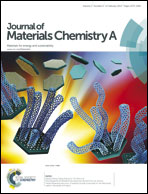Integrating interfacial self-assembly and electrostatic complexation at an aqueous interface for capsule synthesis and enzyme immobilization†
Abstract
A novel concept integrating supramolecular self-assembly and electrostatic complexation at an aqueous liquid–liquid interface to synthesize stable peptide–polymer hybrid capsules was developed. The concept was further applied for enzyme immobilization to give stable and active biocatalysts with low enzyme leakage and high encapsulation efficiency, enzyme loading, and recyclability.


 Please wait while we load your content...
Please wait while we load your content...